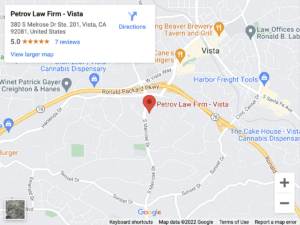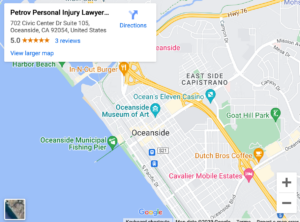
The burden of proof is the standard a party must meet to prove their allegations in court. The person who files the lawsuit must prove the facts of their case. In a personal injury case, the injured party has the burden of proof.
What Are the Burdens of Proof Used in California Cases?

The burden of proof applies in criminal and civil cases. The type of matter determines the level of proof the party must meet to win their case. California Evidence Code §115 lists three different types of burden of proof.
Proof Beyond a Reasonable Doubt
Beyond a reasonable doubt is the burden of proof in a criminal case. The prosecutor must have sufficient evidence to convince the jurors that the defendant is guilty of the crime. However, if a juror has reasonable doubt that the defendant committed the crime, they should vote to acquit the defendant.
Criminal defense attorneys might introduce evidence to refute the evidence presented by the prosecution. Another defense strategy might be to offer a “reasonable” alternative to how the crime was committed or an alternative suspect.
By a Preponderance of the Evidence
Unless otherwise provided by law, the burden of proof is by a preponderance of the evidence. This burden of proof is used in civil cases.
It requires the plaintiff to convince the jury through evidence that there is a greater chance the allegations are truer than not. In other words, there is more than a 50% chance that the defendant committed the conduct the plaintiff alleges.
Clear and Convincing Evidence
Clear and convincing evidence is a level of proof between beyond a reasonable doubt and by a preponderance of the evidence. The jury must find that the evidence presented by the plaintiff proves there is a high probability that a fact is true. Clear and convincing proof is used in some civil cases.
What Is the Burden of Proof for Vista Personal Injury Cases?
Personal injury cases require the injured party to prove their case by a preponderance of the evidence, including car accidents, medical malpractice, slips and falls, and wrongful death. Most personal injury lawsuits require the plaintiff to prove the legal elements of negligence to hold a party liable for damages.
Negligence is failing to take reasonable care in a situation. The legal elements of negligence are:
- Duty of Care – The plaintiff must show that the defendant had a legal duty of care.
- Breach of Duty – The defendant’s actions or inactions breached the duty of care owed to the plaintiff.
- Causation – The defendant’s breach of duty was the proximate and direct cause of the plaintiff’s injuries.
- Damages – The plaintiff sustained damages because of the defendant’s breach of duty.
Damages in a personal injury case include economic and non-economic damages. The law only requires the plaintiff to prove their case by a preponderance of the evidence to receive compensatory damages.
In cases where punitive damages are justified, the plaintiff must prove the case for punitive damages by clear and convincing evidence.
Meeting the Burden of Proof in a Personal Injury Case
The plaintiff presents evidence during the trial that supports their allegations. The goal is to convince the jurors that the allegations are facts.
Examples of evidence used to prove the legal elements of a personal injury case include:
- Videos of the collision or accident
- Physical evidence from the accident scene
- Medical records
- Crash reports and police reports
- Expert testimony and opinions
- Photographs of the accident scene
- Statements made by the parties
- Manufacturing designs
- Eyewitness statements
- Maintenance logs
- Engineering specifications
- Payoff and employment records
The plaintiff presents evidence first. Even though the defendant does not have the burden to disprove the evidence, defense law firms present evidence that casts doubt on the facts the plaintiff needs to prove.
The defense may also raise allegations of contributory fault. California’s pure comparative fault laws reduce the compensation a plaintiff receives if they are partially to blame for causing their injuries. Because the defendant raises the allegations, they would have the burden of proving that the plaintiff was partially at fault.
How Can an Injured Victim Improve Their Chances of Receiving a Fair Settlement?
Your actions after an injury or accident can hurt or help your case.
Things to remember about a personal injury case include:
- Always report motor vehicle accidents by calling 911
- Seek immediate medical attention for injuries
- Do not admit fault for causing an accident or injury
- Take photographs of the accident scene and collect information from eyewitnesses
- Do not provide written or recorded statements to the insurance company
- Document your damages by keeping copies of records
Seeking legal counsel is the best way to understand your options for recovering compensation. Schedule a free case review with a Vista personal injury lawyer as soon as possible after being injured.
Contact a Vista Personal Injury Lawyer for Help Proving Your Case
A Vista personal injury attorney will conduct comprehensive investigations to determine what caused your injury. They’ll develop a strong case with solid evidence and help you meet the burden of proof and recover damages. Contact Petrov Personal Injury Lawyers to schedule your free consultation with an experienced attorney or give a call at (619) 344-0360.


